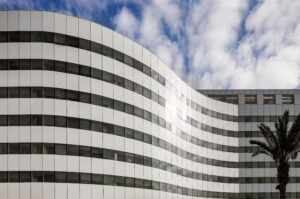Every day in Europe, according to research conducted by the Munich Zoo, some 250,000 birds crash into glass. Annually, that’s more than 90 million collisions in Western Europe alone!
And the USA Association of Ornithology birdwatchers claim more than a billion collisions occur each year in North America.
The main cause is that glass curtain walls reflect the sky. For the bird, “sky” is the direction it flies, and it can’t distinguish between open sky and reflected sky. The impact of colliding at speed with the glass breaks the bird’s neck and it dies as it drops from heights of anywhere between tens to hundreds of meters down. In some cases, the impact is so strong that the glass also shatters, and the pieces drop to the street below. Either way, falling birds and falling glass are serious dangers to anyone at street level.
The force of impact
Most birds weigh between 500 grams to 4 kilos. Their flight speed is between 30 to 90 km per hour. A simple calculation shows that the impact of collision can reach 100 kph per area unit. Part of the impact is absorbed by the bird’s soft body, and the energy distribution at impact.
ALUMINUM CONSTRUCTION offers a high rise tower classing solution that neutralizes noise pollution.
Rami Boneh, CEO
ALUMINUM CONSTRUCTION C.L. Ltd
ALUMINUM CONSTRUCTION Peru Ltd
How can we prevent birds from flying into glass walls?
The best way to answer this is to examine what causes birds to deviate from their direct flight path.
An initial trivial response would be to set up an obstruction. But as we’ve just noted, because the glass reflects the sky, the bird doesn’t relate to the glass wall as an obstruction. The second trivial response would be to use something that naturally frightens the bird. Surprisingly, this idea does contain a solution.
In trials conducted by ALUMINUM CONSTRUCTION in an area with high bird collisions, we found that small flags, installed on the glass panels’ frames, and waving in the wind, are also reflected in the glass. The reflected movement causes the bird to change its flight path.
As part of the trial, an additional experiment was done with LED lighting at specific points around the glass frame, but it seems this had no preventative effect for the birds.
Recently a German company developed glass that is transparent to the human eye, but for birds appears as a jumble of shrubs. That sends the bird a warning signal: avoid at all costs!
This glass contains a screen which only reflects ultraviolet light outwards. The human eye doesn’t register UV, but birds see it well. The reflection forms a complex web of lines which birds see as a thicket, and makes them distance from the area.
Summary
Without any doubt, the phenomenon of bird impact will increase as the number of glass clad high rises and skyscrapers increase. Solutions are vital for saving birds, and preventing danger from falling birds or glass shards to the ground below.
Rami Boneh, Engineer


